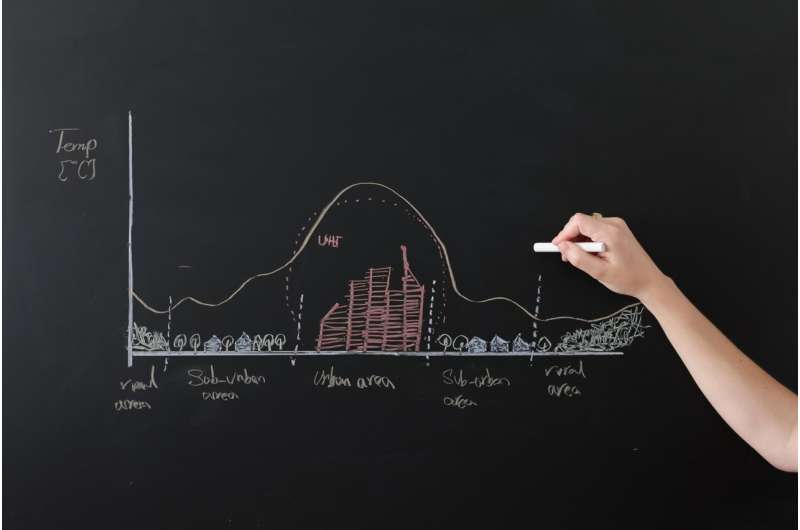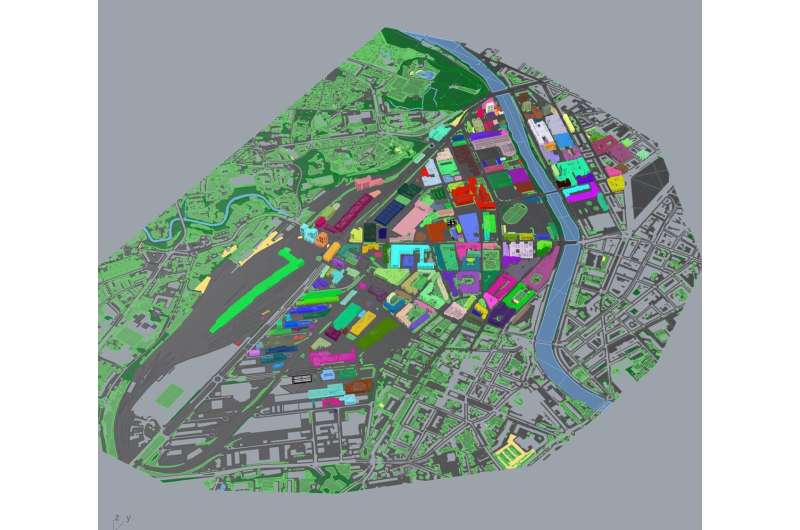Preventing heat islands is a priority for the future of our cities

The summer of 2022 was unprecedented: the series of heat waves between June and August provided a glimpse of how climate change will make cities increasingly arduous places to live in the summer months. That's especially true in the most densely populated areas, where tightly packed buildings and ubiquitous concrete and asphalt surfaces can drive up temperatures and rapidly turn city blocks into furnaces. In addition, the darker colors used for urban structures tend to attract and absorb heat. These dense urban areas are known as heat islands, and they're what two students at EPFL Faculty of Architecture, Civil and Environmental Engineering (ENAC)—Clara Gualtieri and YueWanZhao Yuan—chose to study for their Master's project in environmental engineering. They conducted important research on heat islands and what can be done to mitigate the effects.
Heat islands will become an increasingly serious problem as the planet gets warmer. Most of the world's population now lives in cities, and climate change means they'll be faced with more and more of the direct consequences of extreme temperatures. These temperatures don't just diminish people's health and well-being: they can also be potentially fatal for certain at-risk categories, such as the elderly, chronically ill and homeless. And the methods most people use to cool off—like air conditioning and large fans—require a lot of power and generate even more greenhouse gas emissions, thus fueling the vicious circle of climate change.
To conduct their research on heat islands, Gualtieri and Yuan analyzed surface temperatures in two Geneva neighborhoods (Les Vernets and Pointe-Nord), based on data collected on the ground, building façades and rooftops. These two neighborhoods are undergoing a large-scale transformation and have various urban development projects in the works as part of the PAV (Praille-Acacias-Vernets) program. The two students developed a set of intricate 3D computer models for each neighborhood that describe the neighborhood's current temperature profile, the most likely temperature profile in 2050 if no changes are made, the temperature profile under the IPCC's worst-case scenario (RCP 8.5, where greenhouse gas emissions continue at the same pace, leading to the maximum level of global warming), and the temperature profile if the urban landscape is adapted in order to reduce local temperatures.
A 10-degree Celsius increase
The highest ground-surface temperature that the students found in the two neighborhoods was around 35 degrees Celsius, but their models predicted that this temperature could rise by an average of 10 degrees Celsius, and in some cases by even 15 degrees Celsius in July and August based on their different scenarios.

The models also showed that mitigation strategies such as planting trees and other vegetation to create more green spaces can lower the ground-surface temperature by around 5 degrees Celsius in both neighborhoods. They discovered that plants in particular can be effective, since the shade they produce has more of an impact than grass simply planted in the ground. Gualtieri and Yuan also note two further measures worth studying: the albedo effect—the capacity for lighter colors to reflect heat—and resurfacing rivers or other bodies of water to significantly cool the ambient air are.
The students' findings are the result of a painstaking process whereby they very precisely mapped each neighborhood in order to generate the most complete 3D models possible. Their models incorporate a huge amount of information, including the local morphology and topography, the surface of all built structures (e.g., rooftops, building façades and roads, and smaller structures like ledges and guardrails)—including the structures' size, slope and thermal properties—street furniture, the different materials used, green areas, shaded areas and more. "Our simulations ended up incorporating more than 100,000 surfaces," says Gualtieri.
'A major problem'
Gualtieri and Yuan obtained their data from existing data sets including the Swiss Federal Register of Buildings and Dwellings and weather databases. The students then ran different applications, namely Rhino, a piece of 3D-modeling software, and CitySim, a simulation program developed at EPFL specifically for urban planners. CitySim lets urban planners estimate the thermal and physical proprieties of buildings and their power requirements, which is valuable information for designing strategies to minimize the use of fossil fuels.
"Gualtieri and Yuan's research shows that heat islands will become a major problem by 2050 if we don't start cutting back on fossil-fuel emissions," says Kavan Javanroodi, a postdoc at EPFL's Solar Energy and Building Physics Laboratory (LESO-PB). "Urban planners need to start addressing this issue early on in their projects. This research also highlights what certain strategies can achieve in terms of heat reduction, thus giving Geneva's urban planners a starting point for combating temperature peaks and extreme microclimate conditions in the city's developing neighborhoods."
Provided by Ecole Polytechnique Federale de Lausanne





















